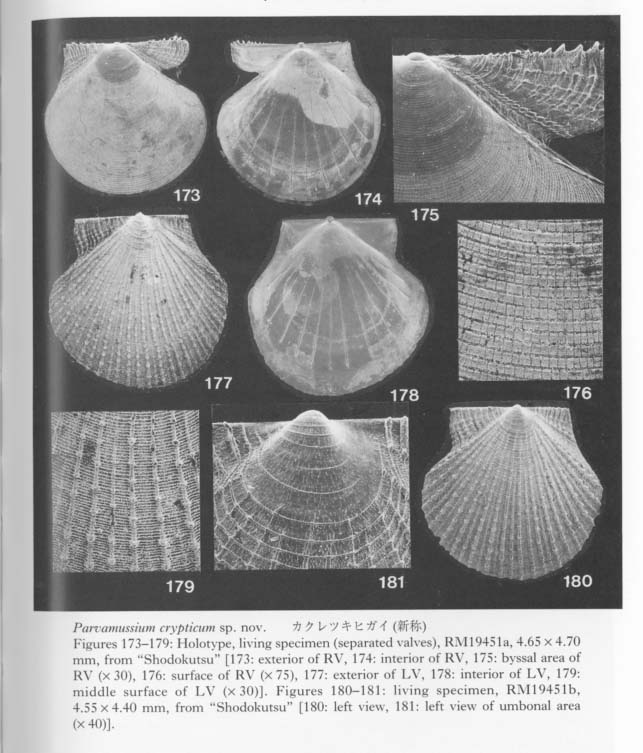Parvamussium crypticum sp. nov.
Figures 173-181

1992. Parvamussium sp., Kase and Hayami, Jour. Moll, Studies, vol.58, p.448, listed,
1993. Parvamussium sp., Hayami and Kase, Univ. Mus. Univ. Tokyo, News, no.27, p.3, fig.5.
Type and material.—Holotype: RM19451a, a living specimen, from cave wall of "Shodokutsu" of Ie Islet, Okinawa. Paratypes: RM19251 (partly living) from the type locality, RM19569 (partly living) from "Daidokutsu" of Ie Islet.
Diagnosis.—Small-sized cryptic species of Parvamussium, characterized by long antero-dorsal disk margin, deep byssal notch, clearly defined auricles, densely spaced commarginal lamellae of RV, more than 40 irregularly tuberculated radial costae of LV, cancellate ornaments on auricles of both valves, and 13-17 slender internal ribs.
Description.—Shell small and thin, rarely exceeding 5.0 mm in length and height, translucent with no color pattern, nearly acline, a little longer than high. Apical angle about 100 degrees. Antero-dorsal and postero-dorsal margins nearly straight; the former considerably longer than the latter. Byssal notch deep, with a strongly tuberclated costa along lower margin of byssal auricle. Disk of RV covered with densely spaced commarginal lamellae, the interval of which essentially consists of rows of simple quadrate prisms. Disk of LV, in contrast, ornamented with more than 40 radial costae, which increase their number by occasional insertion, tuberculated at irregular intervals and crossed by dense commarginal lamellae, though early dissoconch of LV (less than 1mm in length) is free from radial ribs and marked with numerous Camptonectes-striae. Posterior auricle much larger than anterior; both auricles clearly demarcated in each valve, marked with coarse cancellate ornaments. Internal ribs 13-15 (14 on average) in number, slender but sharp. Resilium pit angular, situated about two-fifths of dorsal margin from anterior end. Denticles of provinculum observable, though obscurely, in adult. Pd I large, D-shaped, ranging 181-204 µm in maximum diameter; Pd II absent. No tentacles along mantle margin.
Remarks.—Several living specimens have been found attached to the wall, and numerous empty valves are contained in bottom sediments in the innermost part of "Shodokutsu" and "Daidokutsu", Ie Islet. The present species, however, does not seem to occur at any other localities.
It is somewhat similar to Parvamussium intuscostatum (Yokoyama, 1920) from lower sublittoral to upper bathyal sandy substrates of central-south Japan and Parvamussium holmesii (Dall, 1886) from the similar depths of the Caribbean Sea, but the shell is characterized by much smaller size, longer postero-dorsal margin and absence of divaricate color pattern. In these respects it is closer to Parvamussium carbaseum 'Dijkstra, 1991, from the lower neritic to bathyal substrates of eastern Indonesia. Although the tuberculated radial ribs of LV and many other characters are similar, the byssal notch is decidedly deeper, and the ratio of length/height is a little larger than that of the Indonesian species. It is somewhat similar to Parvamussium cristatellum (Dautzenberg and Bavay, 1912) also from the Banda Sea, but the radial ribs and internal ribs are more numerous and commarginal lamellae of LV are denser in the present species.
As usual in many propeamussiids, the ventral periphery of RV (called marginal apron by Hayami, 1988a), when the valves are tightly closed, is readily reflected along the internal surface of LV, because of the simple prismatic microstructure. The marginal apron is, however, extremely fragile in this species. Consequently, though only superficially, RV looks somewhat smaller than LV, and the internal ribs appear to reach the ventral margin only in RV.
Distribution.—Very abundant in a sublittoral cave of Ie Islet, Ryukyu Islands. No specimen of this species has been found from the caves of Shimoji and Irabu Islets. A similar species occurs in the bottom sediments of "Chandelier Cave" near Koror of Palau Islands, but its internal ribs are generally weaker and more irregular in prominence.